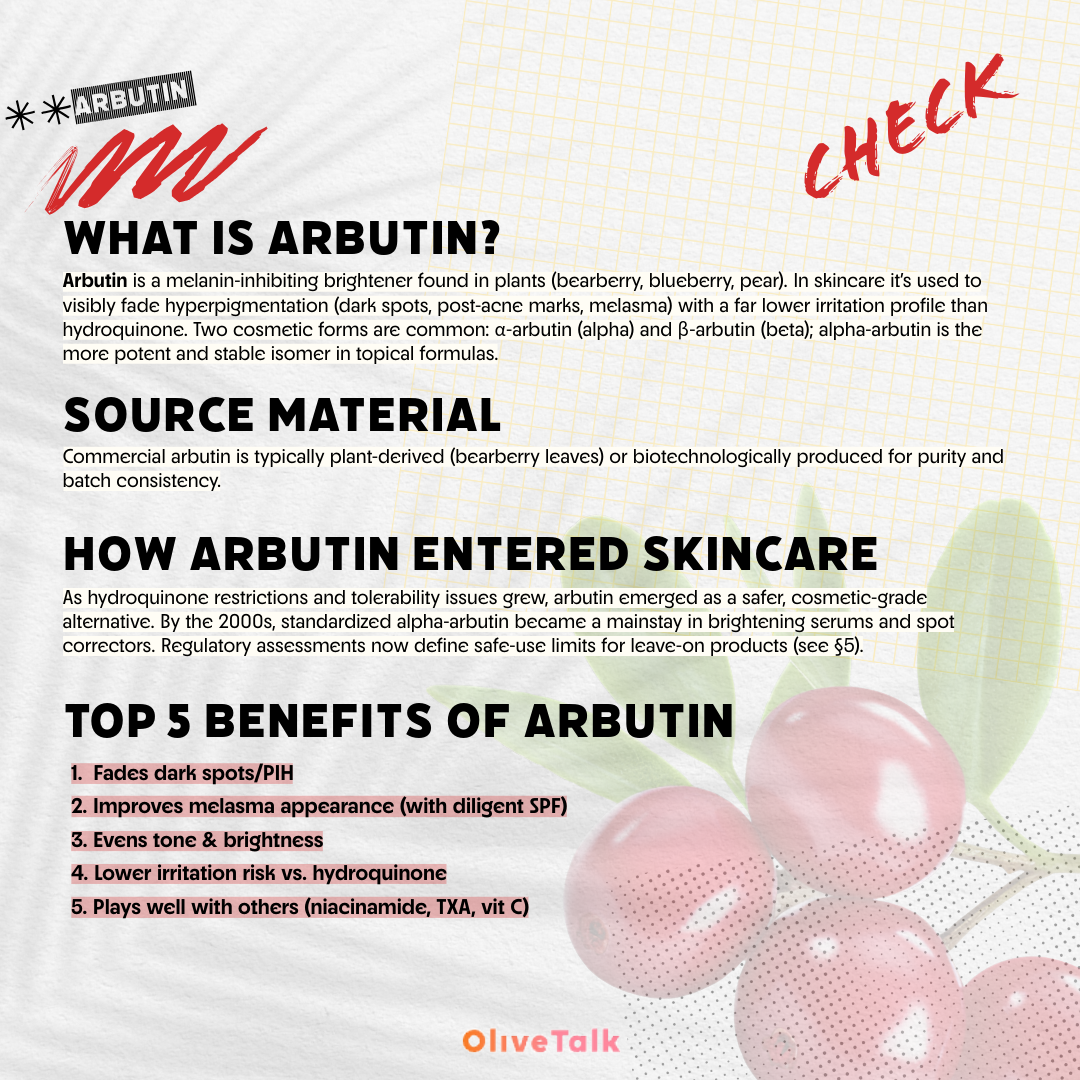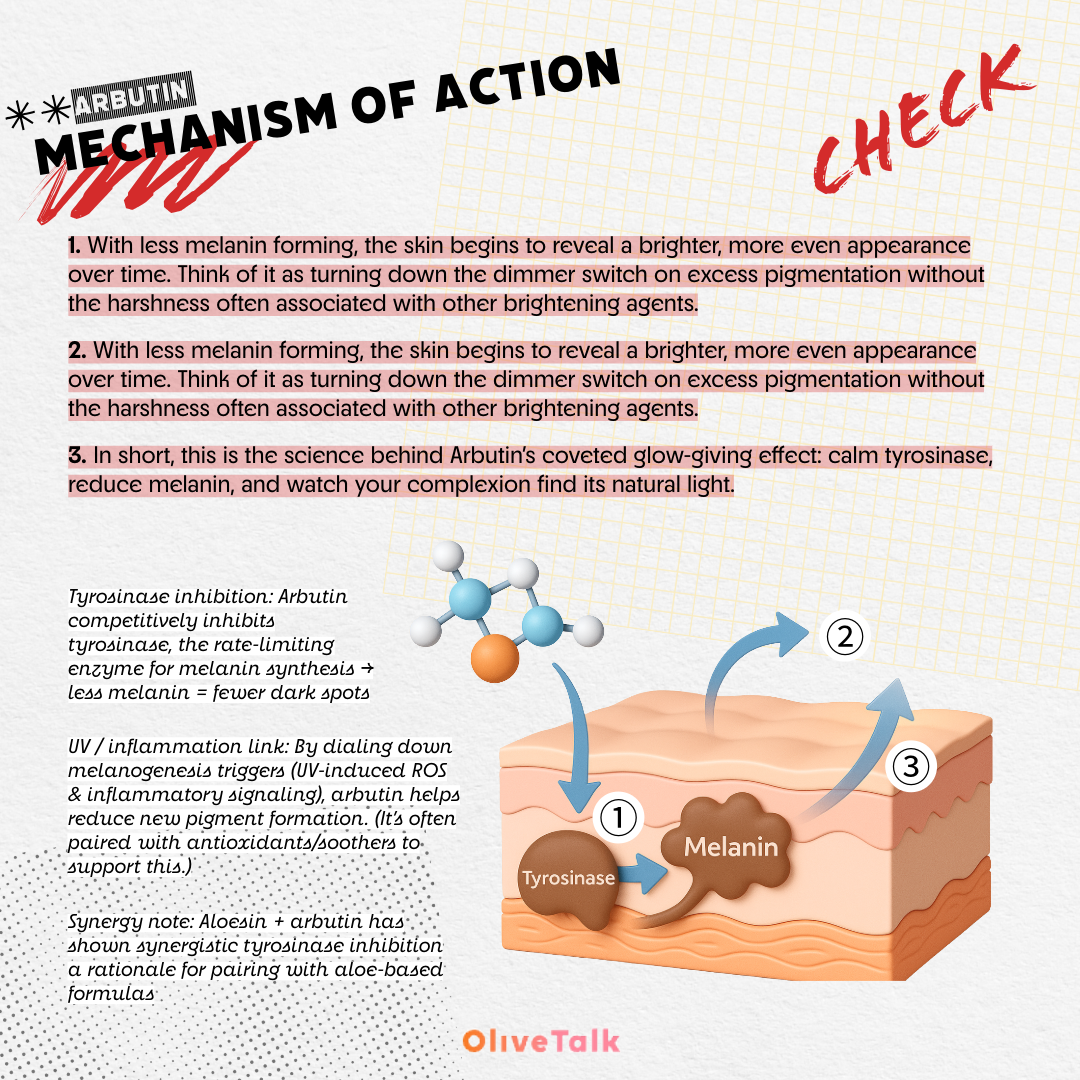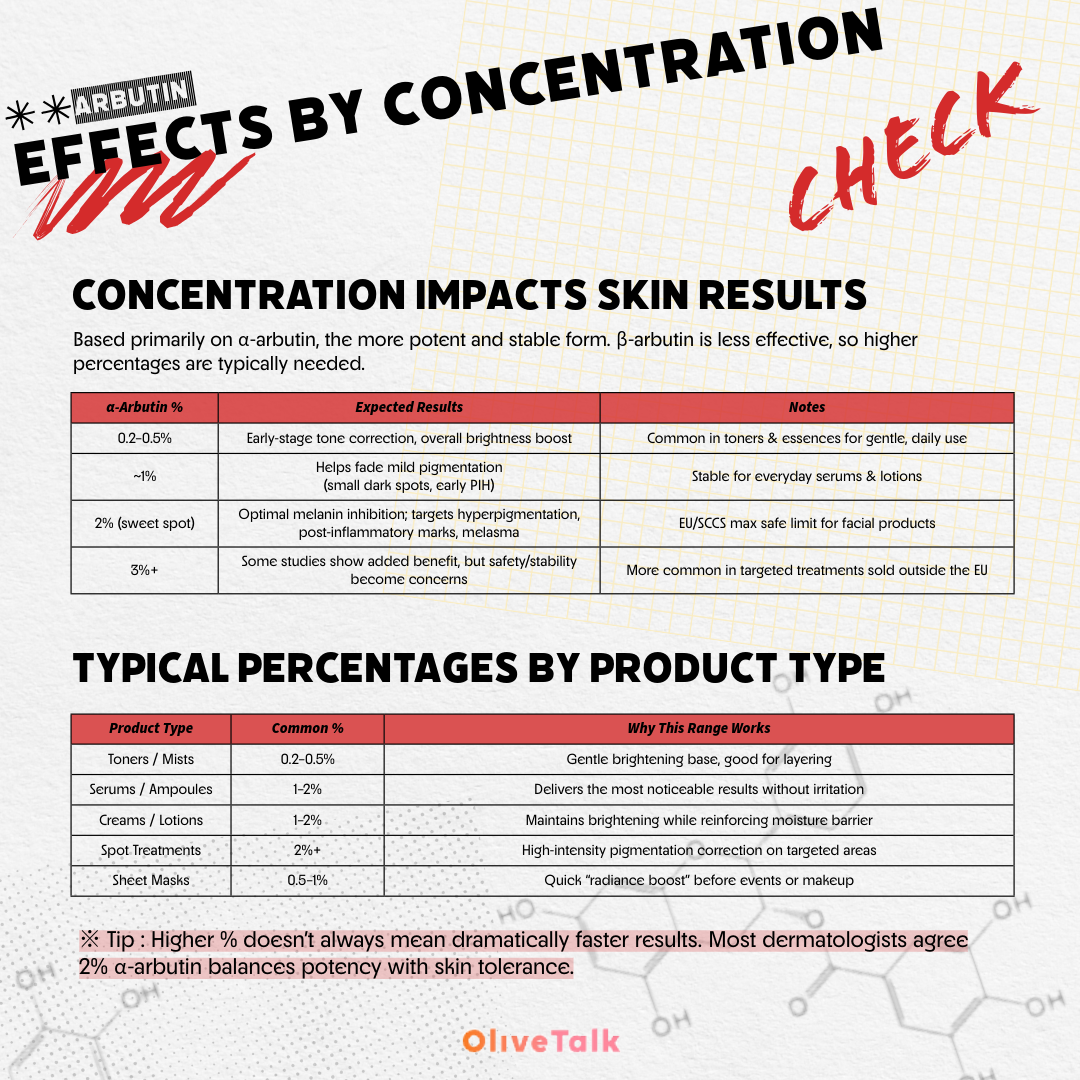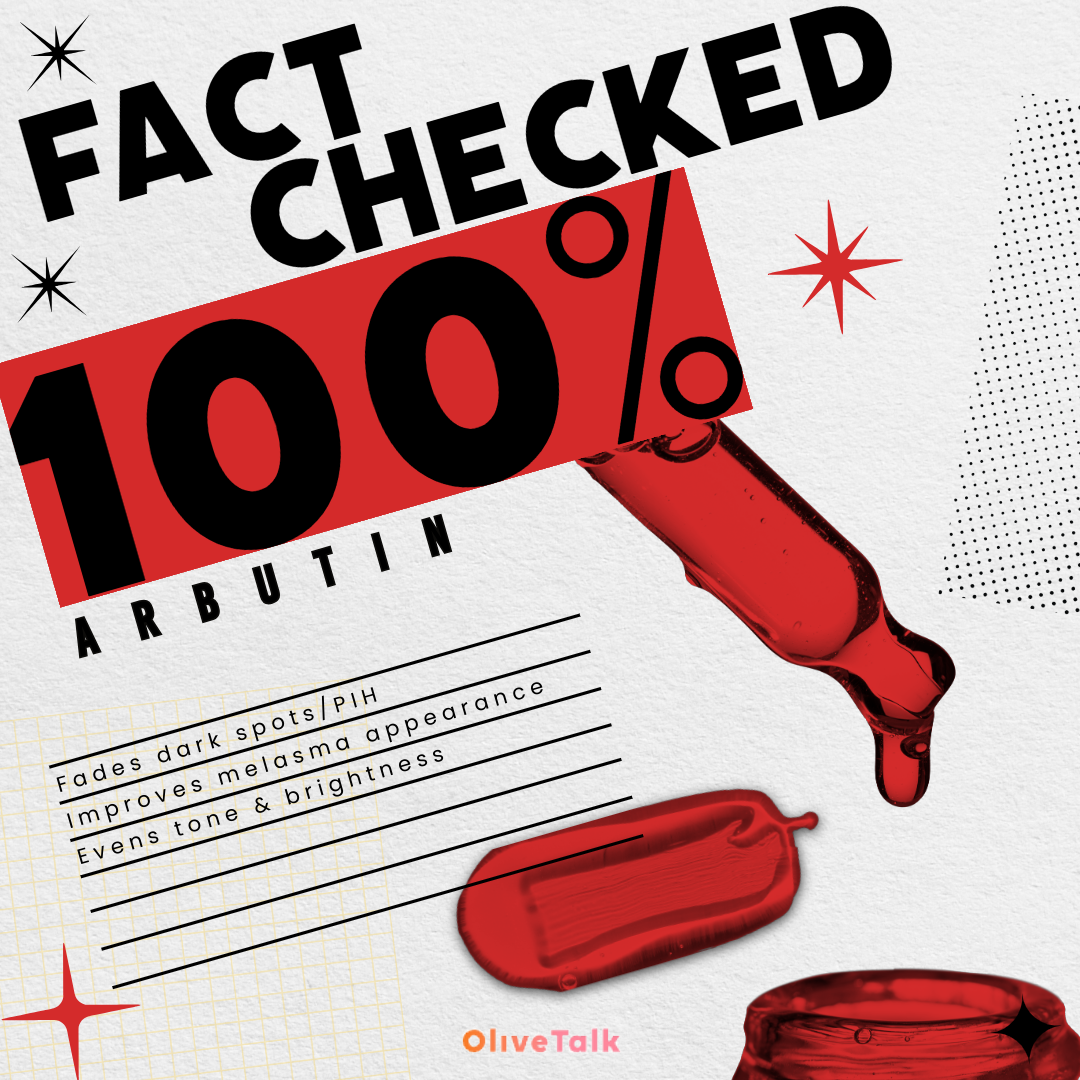

🌿 What is Arbutin?
Arbutin is a melanin‑inhibiting brightener found in plants (bearberry, blueberry, pear). In skincare it’s used to visibly fade hyperpigmentation (dark spots, post‑acne marks, melasma) with a far lower irritation profile than hydroquinone. Two cosmetic forms are common : α‑arbutin (alpha) and β‑arbutin (beta); alpha‑arbutin is the more potent and stable isomer in topical formulas.

Source Material
Commercial arbutin is typically plant‑derived (bearberry leaves) or biotechnologically produced for purity and batch consistency.
How Arbutin Entered Skincare
As hydroquinone restrictions and tolerability issues grew, arbutin emerged as a safer, cosmetic‑grade alternative. By the 2000s, standardized alpha‑arbutin became a mainstay in brightening serums and spot correctors. Regulatory assessments now define safe‑use limits for leave‑on products.

🔬 Mechanism of Action
Tyrosinase inhibition : Arbutin competitively inhibits tyrosinase, the rate‑limiting enzyme for melanin synthesis → less melanin = fewer dark spots.
UV / inflammation link : By dialing down melanogenesis triggers (UV‑induced ROS & inflammatory signaling), arbutin helps reduce new pigment formation. (It’s often paired with antioxidants/soothers to support this.)
Synergy note : Aloesin + arbutin has shown synergistic tyrosinase inhibition a rationale for pairing with aloe‑based formulas.

Effect by Concentration (and safety)
Typical cosmetic usage (leave‑on) : 1–2% α‑arbutin is common for serums/spot care.
Regulatory safety (EU/SCCS 2023) : ①α‑Arbutin: safe up to 2% in face creams; 0.5% in body lotions. ②β‑Arbutin: safe up to 7% in face creams.
● How Arbutin Concentration Impacts Skin Results
(Based primarily on α-arbutin, the more potent and stable form. β-arbutin is less effective, so higher percentages are typically needed.)
α-Arbutin % / Expected Results / Notes
- 0.2–0.5% / Early-stage tone correction, overall brightness boost / Common in toners & essences for gentle, daily use
- ~1% / Helps fade mild pigmentation (small dark spots, early PIH) / Stable for everyday serums & lotions
- 2% (sweet spot) / Optimal melanin inhibition; targets hyperpigmentation, post-inflammatory marks, melasma / EU/SCCS max safe limit for facial products
- 3%+ / Some studies show added benefit, but safety/stability become concerns / More common in targeted treatments sold outside the EU
Tip : Higher % doesn’t always mean dramatically faster results. Most dermatologists agree 2% α-arbutin balances potency with skin tolerance.
● Typical α-Arbutin Percentages by Product Type
Product Type / Common % / Why This Range Works
- Toners, Mists / 0.2–0.5% / entle brightening base, good for layering
- Serums, Ampoules / 1–2% / Delivers the most noticeable results without irritation
- Creams, Lotions / 1–2% / Maintains brightening while reinforcing moisture barrier
- Spot Treatments / 2%+ / High-intensity pigmentation correction on targeted areas
- Sheet Masks / 0.5–1% / Quick “radiance boost” before events or makeup

<Top 5 Skincare Products Infused with Arbutin Extract>
1. COSRX The Alpha‑Arbutin 2% Discoloration Care Serum
Content : 2%
Country : KR
2. Beauty of Joseon Glow Deep Serum
Content : 2%
Country : KR
3. TIA’M Vita B3 Source
Content : 2%
Country : KR
4. Skin&Lab Vegan Bakuchiol 0.2% + Alpha‑Arbutin 2% Serum
Content : 100%
Country : KR
5. MEDITHERAPY Arbutin Skin Booster Serum
Content : 2%
Country : KR
Clinical Evidence
Alpha‑arbutin in melasma : A recent randomized trial of a 5% α‑arbutin + 2% kojic acid cream improved melasma with fewer adverse events vs. triple‑combination therapy.
Visual idea: MASI score line graph AAK trending down more smoothly than comparator.
Mechanism‑level reviews : Comprehensive tyrosinase‑inhibitor reviews reaffirm arbutin’s enzyme‑targeting action and note synergistic pairings
Then vs. Now
Then : “Whitening” creams with β‑arbutin in basic emulsions.
Now : Stabilized α‑arbutin at 1–2% in elegant serums, paired with niacinamide, TXA, vitamin C, and SPF for multi‑pathway pigment control plus clear safety guardrails from SCCS.
Pro Tips (derm‑nerd but practical)
Use daily + SPF: No brightener wins against unprotected UV.
Pair smartly: Niacinamide (pigment transfer), TXA (plasmin pathway), vitamin C (ROS), azelaic acid (inflammation/keratin).
Be patient: Expect 4–8 weeks for visible spot fading; stubborn melasma may take 12+ weeks.
Sensitive skin? Start 3–4x/week, then up to daily. Alpha‑arbutin 2% is a sweet spot for efficacy with low irritation.
Avoid mixing with strong AHAs at the same time if you’re easily reactive; alternate AM/PM.

📚 References
SCCS (2023) final opinion—α‑arbutin 2% face / 0.5% body; β‑arbutin 7% face (safe). Public Health+1
Degen et al., 2015—SCCS safety opinion on α‑arbutin. PubMed
Zolghadri et al., 2019—Comprehensive review of tyrosinase inhibitors; aloesin + arbutin synergy. PMC
Garcia‑Jimenez et al., 2017—Kinetics of tyrosinase acting on α/β‑arbutin. PMC
Tantanasrigul et al., 2024/2025—Clinical trial: 5% α‑arbutin + 2% kojic acid effective in melasma with fewer AEs. PMCPubMedWiley Online Library
Verywell Health (2024)—Consumer‑friendly overview of arbutin types and timelines. Verywell Health
COSRX product page—α‑arbutin 2% serum. COSRX Official
Beauty of Joseon product page—α‑arbutin 2% serum. Beauty of Joseon
TIA’M (YesStyle/INCIdecoder)—arbutin 2% serum. YesStyleINCIDecoder
 77Comments
77Comments-
 FemaleCombination11 days agoWoww this is probably the clearest breakdown abt alpha arbutin ive ever read
FemaleCombination11 days agoWoww this is probably the clearest breakdown abt alpha arbutin ive ever read FemaleOily11 days agoFr super helpful
FemaleOily11 days agoFr super helpful -
 FemaleOily11 days agoAlways wondered if going above 2% will work more. Interesting that 2% is the best
FemaleOily11 days agoAlways wondered if going above 2% will work more. Interesting that 2% is the best -
 FemaleCombination11 days agoWonder why arbutin doesn't get more effective as its concentration increase unlike other ingredients 👀
FemaleCombination11 days agoWonder why arbutin doesn't get more effective as its concentration increase unlike other ingredients 👀 -
 FemaleSensitive11 days agoArbutin was the first ingredient that actually worked on my stubborn PIH
FemaleSensitive11 days agoArbutin was the first ingredient that actually worked on my stubborn PIH FemaleDry11 days agoHow long did it take for u to feel the effect?
FemaleDry11 days agoHow long did it take for u to feel the effect? FemaleSensitive11 days ago@Female/Dry It took at least 6 weeks
FemaleSensitive11 days ago@Female/Dry It took at least 6 weeks FemaleDry11 days ago@Female/Sensitive I should try it out too 👀 thx girlll
FemaleDry11 days ago@Female/Sensitive I should try it out too 👀 thx girlll -
 FemaleSensitive11 days agoInteresting that EU only allows 2% max for facial things
FemaleSensitive11 days agoInteresting that EU only allows 2% max for facial things -
 FemaleCombination11 days agoPairing with niacinamide was the best for me. My skin tone got a lot more even
FemaleCombination11 days agoPairing with niacinamide was the best for me. My skin tone got a lot more even FemaleDry11 days agoLove the combo tooooo
FemaleDry11 days agoLove the combo tooooo -
 FemaleCombination11 days agoLove that it’s effective but still gentle !!
FemaleCombination11 days agoLove that it’s effective but still gentle !! -
 FemaleOily11 days agoAnyone with oily skin who tried the cosrx one??
FemaleOily11 days agoAnyone with oily skin who tried the cosrx one?? -
 FemaleOily11 days agoI think they works best for newer pigmentation
FemaleOily11 days agoI think they works best for newer pigmentation FemaleCombination11 days agoIs that why my old sunspots won't even budge?? I just thought that this ingredient is useless..
FemaleCombination11 days agoIs that why my old sunspots won't even budge?? I just thought that this ingredient is useless.. -
 FemaleSensitive11 days agoHas anyone tried pairing it with vita c?? Wonder if the combo is worth trying or be irritating
FemaleSensitive11 days agoHas anyone tried pairing it with vita c?? Wonder if the combo is worth trying or be irritating FemaleCombination10 days agoWont recommend to a sensitive skin
FemaleCombination10 days agoWont recommend to a sensitive skin -
 FemaleSensitive11 days agoThx for such a helpful breakdown 💕💕
FemaleSensitive11 days agoThx for such a helpful breakdown 💕💕 -
 FemaleCombination10 days agoLove how it is gentle enough for daily use
FemaleCombination10 days agoLove how it is gentle enough for daily use -
 FemaleOily10 days agoDidn't expect it to work but my acne marks got much lighter
FemaleOily10 days agoDidn't expect it to work but my acne marks got much lighter -
 FemaleOily10 days agoLk my fav brightening ingredient
FemaleOily10 days agoLk my fav brightening ingredient -
 FemaleCombination10 days agoIt deserves more hype than it gets rn
FemaleCombination10 days agoIt deserves more hype than it gets rn FemaleOily10 days ago100% agree
FemaleOily10 days ago100% agree -
 FemaleSensitive10 days agoGood reminder that SPF is non negotiable
FemaleSensitive10 days agoGood reminder that SPF is non negotiable FemaleDry10 days agoI learned it the hard way 😭😭
FemaleDry10 days agoI learned it the hard way 😭😭 -
 FemaleCombination10 days agoPrefer arbutin than vita c since it never stings
FemaleCombination10 days agoPrefer arbutin than vita c since it never stings FemaleSensitive10 days agoSame here. Works way better than vita c
FemaleSensitive10 days agoSame here. Works way better than vita c -
 FemaleCombination10 days agoLove the Boj glow deep one. Sooo gentle and effective
FemaleCombination10 days agoLove the Boj glow deep one. Sooo gentle and effective -
 FemaleOily10 days agoIt took me 2 months to feel the difference and it payed off
FemaleOily10 days agoIt took me 2 months to feel the difference and it payed off -
 FemaleCombination10 days agoDefinitely HG for hyperpigmentation
FemaleCombination10 days agoDefinitely HG for hyperpigmentation -
 FemaleSensitive10 days agoLove your detailed post 💞
FemaleSensitive10 days agoLove your detailed post 💞 -
 FemaleSensitive10 days agoIt works gradually. Patience is needed
FemaleSensitive10 days agoIt works gradually. Patience is needed -
 FemaleDry10 days agoMaybe I should try using for a few weeks more. I was just about to give up but the comments....😅
FemaleDry10 days agoMaybe I should try using for a few weeks more. I was just about to give up but the comments....😅 FemaleCombination10 days agoU shouldddd I took more than 7weeks 😂😂
FemaleCombination10 days agoU shouldddd I took more than 7weeks 😂😂 -
 FemaleCombination10 days agoI always layer it under my moisturizer and i think it reduces dryness
FemaleCombination10 days agoI always layer it under my moisturizer and i think it reduces dryness FemaleCombination10 days agoI think ppl overlook how hydrating arbutin serums can be fr
FemaleCombination10 days agoI think ppl overlook how hydrating arbutin serums can be fr -
 FemaleOily10 days agoAnyone tried the skin&lab one??wonder how it will be like with bakuchiol
FemaleOily10 days agoAnyone tried the skin&lab one??wonder how it will be like with bakuchiol FemaleOily10 days agoIm curious too 👀
FemaleOily10 days agoIm curious too 👀 -
 FemaleCombination10 days agoOmg this ingredient sounds so new to me😯😯
FemaleCombination10 days agoOmg this ingredient sounds so new to me😯😯 -
 FemaleSensitive10 days agoLove that arbutin plays well with so many other actives
FemaleSensitive10 days agoLove that arbutin plays well with so many other actives FemaleDry10 days agoFr it makes it way easier to build a routine without irritation
FemaleDry10 days agoFr it makes it way easier to build a routine without irritation -
 FemaleCombination10 days agoI think texture matters too. Gel type arbutin were better than the creamier ones
FemaleCombination10 days agoI think texture matters too. Gel type arbutin were better than the creamier ones -
 FemaleSensitive10 days agoDidn't know that arbutin could be layered with niacinamide 👀👀
FemaleSensitive10 days agoDidn't know that arbutin could be layered with niacinamide 👀👀 -
 FemaleOily10 days agoThe fade is subtle so coudnt notice but noticeable when compared with old pictures
FemaleOily10 days agoThe fade is subtle so coudnt notice but noticeable when compared with old pictures -
 FemaleOily10 days agoMy PIH around chin faded a lot with consistent usage
FemaleOily10 days agoMy PIH around chin faded a lot with consistent usage -
 FemaleCombination10 days agoThere were no difference at all. I used it for more than two months
FemaleCombination10 days agoThere were no difference at all. I used it for more than two months -
 FemaleSensitive10 days agoIt oxidized so fast when I kept it around sunlight. Be careful guys
FemaleSensitive10 days agoIt oxidized so fast when I kept it around sunlight. Be careful guys -
 FemaleDry10 days agoI love using arbutin right after exfoliation. Feels like it sinks in better
FemaleDry10 days agoI love using arbutin right after exfoliation. Feels like it sinks in better -
 FemaleCombination10 days agoWonder which product to begin with
FemaleCombination10 days agoWonder which product to begin with FemaleNormal10 days agoIve started with the cosrx one and it wasnt bad
FemaleNormal10 days agoIve started with the cosrx one and it wasnt bad FemaleCombination10 days ago@Female/Normal Is it working?
FemaleCombination10 days ago@Female/Normal Is it working? FemaleNormal10 days ago@Female/Combination Ive only used it for 2weeks so no for now but still no breakouts
FemaleNormal10 days ago@Female/Combination Ive only used it for 2weeks so no for now but still no breakouts FemaleCombination10 days ago@Female/Normal Oh I see sounds not bad for a beginner 🤔 thx
FemaleCombination10 days ago@Female/Normal Oh I see sounds not bad for a beginner 🤔 thx -
 FemaleNormal10 days agoEven though it works slowly, love that it wont make my skin freak out like other strong actives
FemaleNormal10 days agoEven though it works slowly, love that it wont make my skin freak out like other strong actives -
 FemaleCombination10 days agoLove that it has no mixing issues with other ingredients
FemaleCombination10 days agoLove that it has no mixing issues with other ingredients -
 FemaleNormal10 days agoMy forehead spots lightened most noticeably
FemaleNormal10 days agoMy forehead spots lightened most noticeably -
 FemaleCombination10 days agoIt won't make my skin peel or purge. Love it
FemaleCombination10 days agoIt won't make my skin peel or purge. Love it -
 FemaleNormal10 days agoThe most gentle brightening starter
FemaleNormal10 days agoThe most gentle brightening starter -
 FemaleSensitive10 days agoWhat is the side effect of high concentration??
FemaleSensitive10 days agoWhat is the side effect of high concentration?? -
 FemaleOily10 days agoDidn't know the difference between alpha and beta arbutin 😲😲
FemaleOily10 days agoDidn't know the difference between alpha and beta arbutin 😲😲 -
 FemaleNormal10 days agoInteresting🌟🌟🌟 sounds so new to me
FemaleNormal10 days agoInteresting🌟🌟🌟 sounds so new to me -
 FemaleNormal10 days agoWhich one is more effective? Vita c or arbutin??
FemaleNormal10 days agoWhich one is more effective? Vita c or arbutin?? -
 FemaleCombination10 days agoCan someone recommend me a sheet mask with arbutin in it?
FemaleCombination10 days agoCan someone recommend me a sheet mask with arbutin in it? FemaleNormal10 days agoI'm curious too. Using arbutin in a sheet mask form sounds nice
FemaleNormal10 days agoI'm curious too. Using arbutin in a sheet mask form sounds nice -
 FemaleCombination10 days agoWhy is alpha arbutin only safe up to 0.5% in body cream???
FemaleCombination10 days agoWhy is alpha arbutin only safe up to 0.5% in body cream??? FemaleNormal10 days agoOh fr I thought ingredients will be less irritating to the body skin
FemaleNormal10 days agoOh fr I thought ingredients will be less irritating to the body skin -
 FemaleSensitive10 days agoAloesin+arbutin synergy sounds so interesting ✨️✨️
FemaleSensitive10 days agoAloesin+arbutin synergy sounds so interesting ✨️✨️ FemaleOily10 days agoWonder which kind synergy they would have. Soothing? Or brightening effect boost up?
FemaleOily10 days agoWonder which kind synergy they would have. Soothing? Or brightening effect boost up? -
 FemaleNormal10 days agoGentle but not that dramatic
FemaleNormal10 days agoGentle but not that dramatic -
 FemaleNormal10 days agoWhere should i buy the meditherapy one??
FemaleNormal10 days agoWhere should i buy the meditherapy one?? -
 FemaleCombination10 days agoIs there a reason they used beta arbutin instead of alpha in the past?
FemaleCombination10 days agoIs there a reason they used beta arbutin instead of alpha in the past? -
 FemaleNormal10 days agoIt deserves more hype fr
FemaleNormal10 days agoIt deserves more hype fr -
 FemaleCombination10 days agoConsistency matters more than concentration with arbutin
FemaleCombination10 days agoConsistency matters more than concentration with arbutin -
 FemaleNormal10 days agoIs aloesin the same thing with aloe??
FemaleNormal10 days agoIs aloesin the same thing with aloe?? -
 FemaleSensitive10 days agoDo all of ur rec products contain alpha arbutin not beta?
FemaleSensitive10 days agoDo all of ur rec products contain alpha arbutin not beta? FemaleOily10 days agoAlso wondering. Only cosrx and skin&Lab mentioned the term alpha
FemaleOily10 days agoAlso wondering. Only cosrx and skin&Lab mentioned the term alpha -
 FemaleNormal10 days agoInteresting that it also works in melasma
FemaleNormal10 days agoInteresting that it also works in melasma